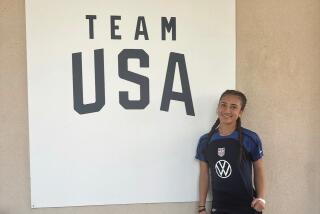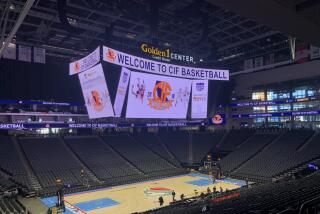Incentives for Education in Sports
- Share via
WASHINGTON — Once in a while somebody comes up with an idea that makes so much sense it ought to be mandatory everywhere, for everybody. Sallie Mae, the nation’s largest source of funding for educational loans, did so recently when it launched the Sallie Mae Cup, a new athletic/academic competition for high school students.
Here’s how it works: At the end of each academic year, a school will compute the average winning percentage of its top eight sports programs (girls and boys), and the grade point averages of all the students who competed in those sports. Schools will then be ranked, with GPAs counting for 60 percent of the standings and winning percentages 40 percent. The winning high school will receive an engraved cup from Sallie Mae, plus $25,000 in college scholarship money.
It’s simple, incentive-based, and hopefully will reinforce the notion in high school locker rooms that sports and academics can and should go hand-in-hand. “We hope we’ve come up with something that rewards the right things,” Paul Carey, a Sallie Mae executive vice-president, said the other day.
Perhaps most important around here is that every high school in the greater D.C. metropolitan area--there are about 250--will be eligible. Even small schools can compete; Sallie Mae will allow schools that don’t have eight varsity sports to use six instead. One day, in a best-case scenario, schools all over the country will have a chance to compete, locally, for a Sallie Mae Cup. Right now, though, D.C. is fortunate to get in on the ground floor, along with Kansas City and Philadelphia.
It’s an idea that took root only five months ago. After joining several local business leaders to help salvage a city high school basketball championship, several Sallie Mae executives (with extensive help from D.C.-based sports management firm ProServ) decided to take their involvement and commitment to high school sports a step further. It’s a huge step as it turns out. More than 600 schools will compete nationally for scholarship money to be awarded in June of 2000, once all the athletic competition and schoolwork is completed. “It’s exceeded every expectation,” Carey said. “We simply didn’t imagine this.”
In Kansas, Sallie Mae requested and received the help of Danny Manning, who attended the University of Kansas in Lawrence. In Philly, Sallie Mae enlisted the NBA’s Malik Rose (San Antonio Spurs) and the WNBA’s Dawn Staley (Charlotte Sting) who both went to high school there. In the D.C. area, U.S. gold medalist and World Cup soccer champion Mia Hamm returned to her high school, Lake Braddock in Northern Virginia, to introduce the program.
I asked Hamm if the Sallie Mae program runs the risk of alienating the superjock who might not want his or her athletic prowess in any way linked to academic standing, beyond simple eligibility. “Look, I wasn’t the best in the classroom,” she said candidly. “Soccer was my way through a lot of doors. But I hope this challenges athletes to be better students. Yeah, everybody loves a winner, but once that’s come and gone, then what? I think a lot of kids, particularly those who are involved in sports, respond better when challenged a lot of times. Just because you go to school doesn’t mean you’re educated. Too many kids become bored, and need to be challenged. I think this will challenge them in the right way.”
And in a necessary way. The only down side to athletes performing at world-class levels at younger ages--Serena and Venus Williams, Martina Hingis, Kevin Garnett, Kobe Bryant--is when their mommas and daddys, cousins and friends, AAU coaches and shoe rep start feeding them all this junk about a high school education being unnecessary.
OK, that’s not going to stop. But since it won’t, the Sallie Mae program appeals to the one thing a lot of high school jocks cannot resist: the challenge of competition. Hey, everything’s about marketing these days, presentation, packaging. Sad perhaps, but true. In a perfect world, you wouldn’t have to bribe high school kids to study. But we’re far from perfect, so far in fact that some brilliantly conceived packaging is necessary. If only a fraction of the high schools in a city or district are involved, it won’t work. But with everybody knowing the stakes, it can work. You can’t win the Cup or win dough for college just by going undefeated. You may have to go undefeated and finish that English Lit paper to boot!
Linda Burke, the principal at Lake Braddock, beamed after the announcement. “It attempts to put some balance in their lives,” she said. “I think it’s superb.”
When the idea began to percolate, the Sallie Mae executives figured a 50-50 split between athletics and academics would be about right. But after consulting with the National Association of Secondary School Principals, a 60-40 split with academics weighing more was adopted. Other cities are clamoring. “Our thinking has been, ‘Let’s just make certain we can do three (cities) properly,” Carey said. “But with the way this is going, I can’t imagine it won’t expand next year.”
Kids at some schools will feel they have an immediate advantage because that school’s culture already mandates studying, even if you’re the starting quarterback or all-state midfielder. To be sure, there are schools where the environment is already conducive to what Sallie Mae is trying to do. But it’s amazing how quickly gaps are reduced when kids perceive an incentive to do well. As with anything so new, it will take awhile before we can assess the impact, if any, the program has on local high school athletes. But we don’t have to wait to give Sallie Mae a standing ovation for trying something innovative.
An assist certainly wouldn’t hurt either. The newspapers in D.C., Philly and Kansas City ought to run the end-of-year results. USA Today ought to do it when the project expands to more cities. Pressure. Yes, absolutely. The best kind, too. Peer pressure.
More to Read
Get our high school sports newsletter
Prep Rally is devoted to the SoCal high school sports experience, bringing you scores, stories and a behind-the-scenes look at what makes prep sports so popular.
You may occasionally receive promotional content from the Los Angeles Times.






